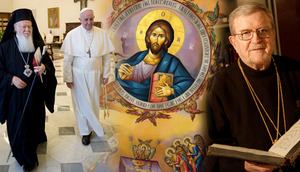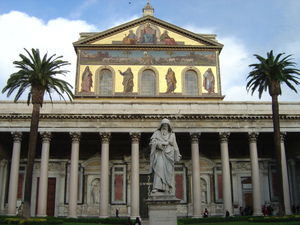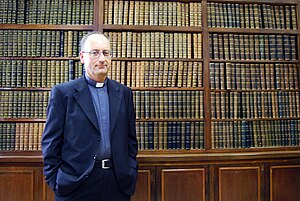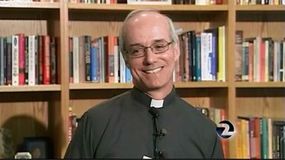 Jesuit Father Alfonso José Gomez met his first Jesuit in 1979 who later turned out to be his religious superior in Argentina; with the passage of time this Jesuit became a bishop, and now pope, Father Jorge Mario Bergoglio (bishop) now Pope Francis. Many of us are still interested to know more about the man who sits in the Chair of Peter. The Indian Jesuit journal Jivan published an interview with Father Gomez conducted by Father John Rose, SJ.
Jesuit Father Alfonso José Gomez met his first Jesuit in 1979 who later turned out to be his religious superior in Argentina; with the passage of time this Jesuit became a bishop, and now pope, Father Jorge Mario Bergoglio (bishop) now Pope Francis. Many of us are still interested to know more about the man who sits in the Chair of Peter. The Indian Jesuit journal Jivan published an interview with Father Gomez conducted by Father John Rose, SJ.
Tag: Jesuits
Matteo Ricci’s cause for sainthood moves to Rome
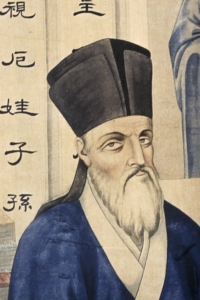 A while ago I mentioned the sainthood study of the 17th century Jesuit Father Matteo Ricci being opened by Diocese of Macerata. The diocesan phase officially closed on May 10th and the findings were sent to the Congregation for Saints at the Holy See.
A while ago I mentioned the sainthood study of the 17th century Jesuit Father Matteo Ricci being opened by Diocese of Macerata. The diocesan phase officially closed on May 10th and the findings were sent to the Congregation for Saints at the Holy See.
Father Taft: we need a new ecclesiology –a startling revolution– Catholics are the no longer the only kids on the block
It is said that “The Eastern Churches have a special vocation in the contemporary world, which is both distinct from, and complementary to, that of the Western Church. Pope John Paul saw it thus, but he was not the only one. The language of the ‘two lungs’ of the Church suggests that the Church’s activity in the world is much diminished when one of the lungs is operating at a reduced capacity – which it certainly is if it is not fully being what it is meant to be.”
A vocation to serve the Churches, East and West, has been radically lived by a New England Province Jesuit priest, Robert F. Taft, for nearly a half-century. Christopher B. Warner published a terrific interview in the Catholic World Report, “Building Bridges Between Orthodox and Catholic Christians” is required reading to get a sense of the Church’s teaching and life.
Father Taft was a professor of mine, and he remains an inspiration and mentor.
Clarence Gallagher, SJ, RIP
The Church mourns Father Clarence Gallagher, SJ, who died yesterday in England.
Francis and Ignatius – saints who rebuilt the Church
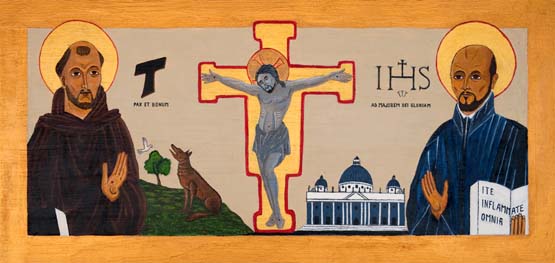
I read this narrative in one of the newsletters I receive. Very curious on these things work out, no?
When the parish priest of a beautiful village of Provence, South of France, asked in January for a new work of art for his parish, he couldn’t imagine that his command would meet the joyful events of the whole church, and of the Society. As this diocesan priest was very close to the Franciscans, and to the Jesuits, he asked a parishioner to create a drawing of St Ignatius and St Francis, and another to transform it in a wood bas relief for his parish. The project was going on, when the new pope, a Jesuit, decided to call himself Francis. This drawing had suddenly a more universal signification, and the artist transformed it also into an icon. Every Jesuit will be able to read it and to appreciate its symbols.
Milan Lach nominated auxiliary bishop of Presov
There is a new auxiliary bishop for Greek Catholic Archeparchy of Presov, Slovakia, Jesuit Father Milan Lach. He is the first Jesuit to be elected a bishop during the pontificate of Pope Francis.
Bishop-elect Lach will join another Jesuit who serves as the Archbishop of Presov, Ján Babjak, 59. The archeparchy has more than 140 thousand people. Archbishop Babjak was just here in the USA making a pastoral visit.
Bishop-elect Milan, 39, has been the vice-dean of the the Faculty of Theology of the University of Trnava. Lach entered the Society of Jesus (the Jesuits) in 1995 and ordained priest in 2001. For 2 years he worked at the Centre of Spirituality East-West of Michal Lacko, where he was also the Jesuit superior. In the 2009 he was awarded a degree in spirituality at the Pontifical Oriental Institute and livingnext door at the Pontifical Russian College.
In 2010 he became a member of the editorial board of the theology journal, Verba Theologica.
Mnohaja l’ita!
Benedictines and Jesuits converge
Last Sunday, Pope Francis, as the bishop of Rome, took possession of his cathedral church, Saint John Lateran. This coming Sunday, 14 April, Pope Francis will take possession of the Papal Basilica of Saint Paul’s outside the Walls in Rome.
A concelebrated Mass will be offered by the Pope, the archpriest, James Cardinal Harvey and the Benedictine monks to whom the pastoral care of the Basilica and the adjoining Monastery are entrusted. The monks are led by Abbot Edmund Power, OSB. He gives an interview to Vatican Radio (be aware, some of the abbot’s facts are wrong).
There is a historical connection between the Benedictines and the Jesuits. True the Benedictines about 1000 years old than the Jesuits but the historical part goes a bit deeper. The Pilgrim, as he was known, went to the Benedictine abbey of Our Lady of Montserrat in Spain, to make a general confession, keep an all-night in vigil before Our Lady’s altar, and to observe the rites of chivalry in preparation for his new life of being a converted sinner. There Ignatius left his sword and knife at the altar of the Black Madonna, he disposed of his fine clothes to a poor man, and adopted rough clothes with sandals and a staff of a pilgrim.
Gonzaga University rejects Knights of Columbus because they are Catholic
The Knights of Columbus are not allowed to officially exist on Gonzaga’s University’s campus because they don’t meet a criterion: that non-Catholics be admitted to the group. The decision by the University Student Life office was communicated by Sue Weitz with the help of Kassi Kain. The KoC is a fraternity (of men) who are practical Catholics.
La Civiltà Cattolica will bridge Church and postmodern world
Here then, is where the mission of a cultural journal such as La Civiltà Cattolica fits in: active participation int he contemporary cultural debate, both to propose and at the same time to spread the Christian faith in a serious way. Its purpose is both to present it clearly and in fidelity to the Magisterium of the Church, and to defend without polemics the truth that is sometimes distorted by unfounded accusation directed at the Ecclesial Community. I would like to point out the Second Vatican Council as a beacon on the path that La Civiltà Cattolica is called to take.
In defense of the Pope, La Civiltà Cattolica‘s is understood to be supportive of the Church by following the indications of the Second Vatican Council. As a journal of the Society of Jesuit and the Church its work to show a relationship faith and reason, faith and culture, faith and science, faith and the public order;to understand the world in which we live in light of the Incarnation. The Journal cuts across the various sectors of the intellectual, spiritual and cultural ambits showing a particular attentiveness with the Catholic Church through the Secretary of State; La Civiltà Cattolica is considered to be not official but authoritative.
Jesuit presence therefore influence in Rome
A significant Jesuit presence in key places for the Church’s ministry of proclaiming and living the Gospel exists that few may not be aware of. Since the time of Saint Ignatius of Loyola, the Society has done some remarkable things for the good of the Church. And every Pope since Paul III has relied on generosity of thinking and action of the Jesuits in Rome. Pope Francis has asked the Society to continue… Presence means influence.
Interesting stats:
- 12 Pontifical residences in Rome are staffed by Jesuits;
- 3 Pontifical institutions for higher learning in Rome: The Gregorian University, the Oriental and Biblical Institutes;
- 1 Radio center (Vatican Radio);
- 1 journal (La Civiltà Cattolica);
- 6 Jesuit cardinals: but only one of them participated in the 2013 conclave, Jorge Mario Cardinal Bergoglio, archbishop of Buenos Aires (Argentina). The other Cardinal entitled to participate, Julius Riyadi Cardinal Darmaatmadja, Archbishop-emeritus of Jakarta (Indonesia), was unable to attend due to ill health;
- The Pontifical Gregorian University indicates that there are 57 Cardinal alumni of Jesuit pontifical institutions in Rome, the Gregorian and the Biblicum (49.6% of all participants in the Conclave). Several of them were also professors at the Gregorian University: Raymond Leo Cardinal Burke, William Joseph Cardinal Levada, Velasio Cardinal DePaolis, CS, Timothy Michael Cardinal Dolan, Francesco Cardinal Coccopalmerio, and Walter Cardinal Kasper (not an exhaustive list.);
- And other works coordinated by the Jesuit Curia under the leadership of the Jesuit Superior General.
